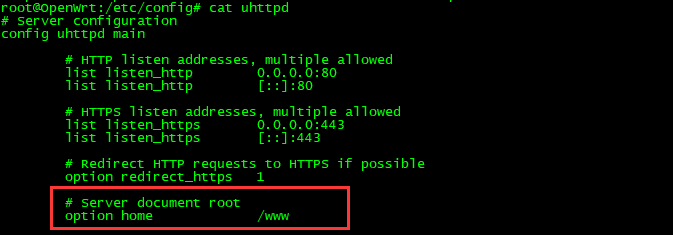luci启动的流程
1、uhttpd Web server的根目录在/etc/config/uhttpd文件中指定为www,主页面为/www/index.html,

2、index.html中指定cgi程序启动脚本为/cgi-bin/luci

3、/cgi-bin/luci脚本,指定缓存路径为/tmp/luci-indexcache,指定cgi启动接口为/usr/lib/lua/luci/sgi/cgi.lua的run()函数

注:可以rm -rf /tmp/luci* 来删除luci的备份文件,这样可以清除缓存,执行修改后的操作。
cgi启动流程
run()函数作为CGI程序的启动入口,代码解析如下
function run()
-- 获取web请求,放于变量r中(包括环境变量,请求数据,出错处理接口)
local r = luci.http.Request(
luci.sys.getenv(),
limitsource(io.stdin, tonumber(luci.sys.getenv("CONTENT_LENGTH"))),
ltn12.sink.file(io.stderr)
)
--创建一个协同程序
local x = coroutine.create(luci.dispatcher.httpdispatch)
local hcache = ""
local active = true
--查看协同程序x的协同状态
while coroutine.status(x) ~= "dead" do
local res, id, data1, data2 = coroutine.resume(x, r)
if not res then
print("Status: 500 Internal Server Error")
print("Content-Type: text/plain\n")
print(id)
break;
end
-- HTTP的响应报文通过io.write()方式写在stdout上,
-- 在由uhttpd架构将这些数据传递给父进程,
-- 通过tcp连接返回给client端。
if active then
if id == 1 then
-- 填写HTTP响应状态行
io.write("Status: " .. tostring(data1) .. " " .. data2 .. "\r\n")
elseif id == 2 then
-- 准备报文头header
hcache = hcache .. data1 .. ": " .. data2 .. "\r\n"
elseif id == 3 then
-- 填写header、blank到stdout上
io.write(hcache)
io.write("\r\n")
elseif id == 4 then
-- 填写body
io.write(tostring(data1 or ""))
elseif id == 5 then
-- 关闭io接口,EOF
io.flush()
io.close()
active = false
elseif id == 6 then
data1:copyz(nixio.stdout, data2)
data1:close()
end
end
end
end
dispatcher启动流程
在上述run()函数中,创建了一个协同程序,调用httpdispatch()函数,而这个函数位于dispatcher.lua中。通过后续的介绍也可以发现,luci真正的主体部分都在dispatcher.lua脚本里,本小节主要对httpdispatch()和dispatch()函数进行介绍。(注:在版本机dispatcher.lua的同目录下有一个dispatcher.luadoc文件,里面介绍dispatcher.lua的参数说明,仅供参考。)
1、httpdispatch():解析请求,获得HTTP request请求参数
// /usr/lib/lua/luci/dispatch.lua
function httpdispatch(request, prefix) http.context.request = request local r = {} context.request = r --解析HTTP request,获取请求路径,并传入dispatch()函数进行处理 local pathinfo = http.urldecode(request:getenv("PATH_INFO") or "", true) if prefix then for _, node in ipairs(prefix) do r[#r+1] = node end end local node for node in pathinfo:gmatch("[^/%z]+") do r[#r+1] = node end determine_request_language() local stat, err = util.coxpcall(function() dispatch(context.request) end, error500) http.close() --context._disable_memtrace() end
2、dispatch():解析请求节点,调度网页显示,分为以下四个部分:
(1)创建节点树node-tree,解析请求路径,获取节点树节点
createtree()函数主要从controller目录下寻找.lua文件,并且调用每个lua文件中的index()函数。这些index函数通过entry(path,target,title,order)函数定义了菜单栏的每个子菜单选项,包括子菜单的节点位置path、调度行为target、页面标题title以及节点顺序order。当解析完index()下的node节点,对应生成一个node-tree。
-- Build the index before if it does not exist yet.
function createtree()
if not index then
createindex()
end
local ctx = context
local tree = {nodes={}, inreq=true}
ctx.treecache = setmetatable({}, {__mode="v"})
ctx.tree = tree
local scope = setmetatable({}, {__index = luci.dispatcher})
for k, v in pairs(index) do
scope._NAME = k
setfenv(v, scope)
v()
end
return tree
end
(2)认证
if type(auth) == "table" and type(auth.methods) == "table" and #auth.methods > 0 then
local sid, sdat, sacl
for _, method in ipairs(auth.methods) do
sid, sdat, sacl = check_authentication(method)
if sid and sdat and sacl then
break
end
end
if not (sid and sdat and sacl) and auth.login then
local user = http.getenv("HTTP_AUTH_USER")
local pass = http.getenv("HTTP_AUTH_PASS")
if user == nil and pass == nil then
user = http.formvalue("luci_username")
pass = http.formvalue("luci_password")
end
if user and pass then
sid, sdat, sacl = session_setup(user, pass)
end
if not sid then
context.path = {}
http.status(403, "Forbidden")
http.header("X-LuCI-Login-Required", "yes")
local scope = { duser = "root", fuser = user }
local ok, res = util.copcall(tpl.render_string, [[<% include("themes/" .. theme .. "/sysauth") %>]], scope)
if ok then
return res
end
return tpl.render("sysauth", scope)
end
http.header("Set-Cookie", 'sysauth=%s; path=%s; SameSite=Strict; HttpOnly%s' %{
sid, build_url(), http.getenv("HTTPS") == "on" and "; secure" or ""
})
http.redirect(build_url(unpack(ctx.requestpath)))
return
end
if not sid or not sdat or not sacl then
http.status(403, "Forbidden")
http.header("X-LuCI-Login-Required", "yes")
return
end
ctx.authsession = sid
ctx.authtoken = sdat.token
ctx.authuser = sdat.username
ctx.authacl = sacl
end
if #required_path_acls > 0 then
local perm = check_acl_depends(required_path_acls, ctx.authacl and ctx.authacl["access-group"])
if perm == nil then
http.status(403, "Forbidden")
return
end
page.readonly = not perm
end
local action = (page and type(page.action) == "table") and page.action or {}
if action.type == "arcombine" then
action = (#requested_path_args > 0) and action.targets[2] or action.targets[1]
end
if cors and http.getenv("REQUEST_METHOD") == "OPTIONS" then
luci.http.status(200, "OK")
luci.http.header("Access-Control-Allow-Origin", http.getenv("HTTP_ORIGIN") or "*")
luci.http.header("Access-Control-Allow-Methods", "GET, POST, OPTIONS")
return
end
if require_post_security(action) then
if not test_post_security() then
return
end
end
(3)会根据action.type处理相应的动作,每个controller下的lua文件的index函数会生成页面的菜单栏并定义各个页面的调用方法
if action.type == "view" then
tpl.render("view", { view = action.path })
elseif action.type == "call" then
local ok, mod = util.copcall(require, action.module)
if not ok then
error500(mod)
return
end
...
elseif action.type == "alias" then
...
elseif action.type == "rewrite" then
...
elseif action.type == "template" then
tpl.render(action.path, getfenv(1))
elseif action.type == "cbi" then
_cbi({ config = action.config, model = action.path }, unpack(requested_path_args))
elseif action.type == "form" then
_form({ model = action.path }, unpack(requested_path_args))
else
local root = find_subnode(menu, {}, true)
if not root then
error404("No root node was registered, this usually happens if no module was installed.\n" ..
"Install luci-mod-admin-full and retry. " ..
"If the module is already installed, try removing the /tmp/luci-indexcache file.")
else
error404("No page is registered at '/" .. table.concat(requested_path_full, "/") .. "'.\n" ..
"If this url belongs to an extension, make sure it is properly installed.\n" ..
"If the extension was recently installed, try removing the /tmp/luci-indexcache file.")
end
end
end




 浙公网安备 33010602011771号
浙公网安备 33010602011771号